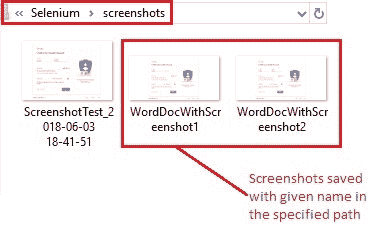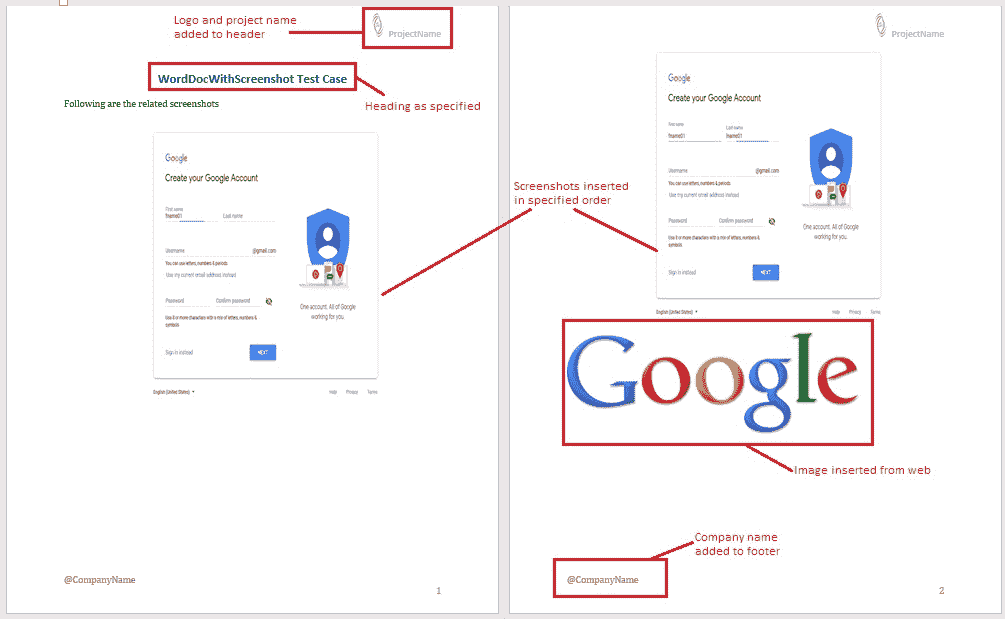# 10G 高级 WebDriver – 将屏幕截图保存到 Word 文档
> 原文: [https://javabeginnerstutorial.com/selenium/10g-advanced-webdriver-saving-screenshots-to-word-document/](https://javabeginnerstutorial.com/selenium/10g-advanced-webdriver-saving-screenshots-to-word-document/)
嗨冠军! 希望您度过愉快的时光[截屏并将其保存在本地](https://javabeginnerstutorial.com/selenium/10f-advanced-webdriver-taking-screenshot/)。 今天,让我们看看如何创建 Word 文档,并将在测试用例中捕获的所有图像插入其中。 每个测试用例都有一个单独的文档,不仅可以帮助我们保持工作空间井井有条,而且搜索特定的屏幕快照也很容易。 最好的部分是,我们将编写代码,以便所有这些事情自动发生而无需任何人工干预。
请允许我直截了当。
## 步骤 1:
下载几个 JAR,使我们的工作更加轻松。
**`java2word-3.3.jar`** - 帮助我们创建 Word 文档并以所需方式对其进行操作。
**`xstream-1.3.1.jar`** – 处理图片
让我们继续从 [https://code.google.com/archive/p/java2word/downloads](https://code.google.com/archive/p/java2word/downloads) (在撰写本文时的下载位置)下载这两个 JAR 文件。 我还将这些 JAR 以及本文中处理的所有其他代码文件一起放在我们的 [GitHub 仓库](https://github.com/JBTAdmin/Selenium)中。
## 步骤 2:
将这些 JAR 添加到我们的项目构建路径中。
之前,我们已经多次看到此过程,因此,我不再重复(有关详细说明,请参阅[文章](https://javabeginnerstutorial.com/selenium/9b-webdriver-eclipse-setup/)的步骤 3)。
## 步骤 3:
创建一个类“`SaveDocument.java`”。
将以下代码添加到类文件中,
```java
import java.io.File;
import java.io.FileNotFoundException;
import java.io.PrintWriter;
import word.api.interfaces.IDocument;
import word.w2004.Document2004;
import word.w2004.Document2004.Encoding;
import word.w2004.elements.BreakLine;
import word.w2004.elements.Heading1;
import word.w2004.elements.Heading3;
import word.w2004.elements.Image;
import word.w2004.elements.Paragraph;
import word.w2004.style.HeadingStyle.Align;
public class SaveDocument {
public static void createDoc(String testCaseName, String[] imgFileNames) {
// Create a document object
IDocument myDoc = new Document2004();
myDoc.encoding(Encoding.UTF_8);
// Inserts one breakline
myDoc.addEle(BreakLine.times(1).create());
// Add client logo to document header
myDoc.getHeader().addEle(Image.from_FULL_LOCAL_PATHL("/Selenium/Logo.png")
.setHeight("30")
.setWidth("20")
.getContent());
// Add Project name to document header
myDoc.getHeader().addEle(Heading3.with(" ProjectName").withStyle().align(Align.RIGHT).create());
// Specify Test case name as document heading
myDoc.addEle(Heading1.with(testCaseName + " Test Case").withStyle().align(Align.CENTER).create());
myDoc.addEle(BreakLine.times(1).create());
// Add a description paragraph
myDoc.addEle(Paragraph
.with("Following are the related screenshots")
.create());
myDoc.addEle(BreakLine.times(1).create());
// Add company name to document footer
myDoc.getFooter().addEle(
Paragraph.with("@CompanyName").create());
// Loop through all the image files
for(String file:imgFileNames){
// Insert each image file to the document
myDoc.addEle(Image.from_FULL_LOCAL_PATHL(
"/Selenium/screenshots/" + file + ".png")
.setHeight("350")
.setWidth("500")
.getContent());
// Insert 2 linebreaks at the end of each inserted image
myDoc.addEle(BreakLine.times(2).create());
}
// Insert an image from web
myDoc.addEle(Image
.from_WEB_URL("http://www.google.com/images/logos/ps_logo2.png"));
// Create the word document specifying a location
File fileObj = new File("\\Selenium\\" + testCaseName + ".doc");
PrintWriter writer = null;
try {
writer = new PrintWriter(fileObj);
} catch (FileNotFoundException e) {
e.printStackTrace();
}
String myWord = myDoc.getContent();
writer.println(myWord);
writer.close();
// Print a confirmation image to console
System.out.println("Word document created successfully!");
}
}
```
每行都提供了注释,以使代码易于说明。
`public static void createDoc(String testCaseName, String[] imgFileNames)` -此方法有两个参数。 第一个是一个字符串,它指定测试用例的名称。 这将是将要创建的单词文档的名称。 第二个参数是作为该测试用例的一部分捕获的所有屏幕快照名称的数组。
在这种方法中,我们将创建一个文档对象并执行诸如
* 添加标题,段落
* 在标题中添加客户徽标和公司名称
* 在页脚中添加公司名称
* 插入作为特定测试用例一部分捕获的所有屏幕截图
* 从网上插入图片(只是为了证明这种情况也是可行的)
* 将单词文档和测试用例的名称保存在特定位置
## 步骤 4:
对“`SaveScreenshot.java`”文件进行了一些修改。
对我们在[先前文章](https://javabeginnerstutorial.com/selenium/10f-advanced-webdriver-taking-screenshot/)中创建的“`SaveScreenshot.java`”类进行了一些更改。
1. 删除生成时间戳的函数,并
2. 文件扩展名从“`.jpg`”更改为“`.png`”
现在的代码看起来像这样,
```java
import java.io.File;
import java.io.IOException;
import org.apache.commons.io.FileUtils;
import org.openqa.selenium.OutputType;
import org.openqa.selenium.TakesScreenshot;
import org.openqa.selenium.WebDriver;
public class SaveScreenshot {
public static void capture(String screenshotName, WebDriver driver) {
// Cast driver object to TakesScreenshot
TakesScreenshot screenshot = (TakesScreenshot) driver;
// Get the screenshot as an image File
File src = screenshot.getScreenshotAs(OutputType.FILE);
try {
// Specify the destination where the image will be saved
File dest = new File("\\Selenium\\screenshots\\" + screenshotName + ".png");
// Copy the screenshot to destination
FileUtils.copyFile(src, dest);
} catch (IOException ex) {
System.out.println(ex.getMessage());
}
}
}
```
## 示例场景
1. 打开 Firefox 浏览器。
2. 导航到 Google 帐户创建页面
3. 通过 ID 找到名字文本框
4. 输入“`fname01`”作为名字
5. 截取屏幕截图,并将其命名为“`testCaseName+1`”
6. 按名称找到姓氏文本框
7. 输入“`lname01`”作为姓氏
8. 截取屏幕截图并将其命名为“`testCaseName+2`”
9. 在指定位置创建一个 word 文档,并将这两个屏幕截图都插入其中。
### JUnit 代码:
`WordDocWithScreenshotTest.java`类
```java
import java.util.concurrent.TimeUnit;
import org.junit.After;
import org.junit.Before;
import org.junit.Test;
import org.openqa.selenium.By;
import org.openqa.selenium.WebDriver;
import org.openqa.selenium.WebElement;
import org.openqa.selenium.firefox.FirefoxDriver;
import com.blog.utilities.SaveDocument;
import com.blog.utilities.SaveScreenshot;
public class WordDocWithScreenshotTest {
//Declaring variables
private WebDriver driver;
private String baseUrl;
private String testCaseName = "WordDocWithScreenshot";
@Before
public void setUp() throws Exception{
// Selenium version 3 beta releases require system property set up
System.setProperty("webdriver.gecko.driver", "E:\\Softwares\\"
+ "Selenium\\geckodriver-v0.10.0-win64\\geckodriver.exe");
// Create a new instance for the class FirefoxDriver
// that implements WebDriver interface
driver = new FirefoxDriver();
// Implicit wait for 5 seconds
driver.manage().timeouts().implicitlyWait(5, TimeUnit.SECONDS);
// Assign the URL to be invoked to a String variable
baseUrl = "https://accounts.google.com/SignUp";
}
@Test
public void testPageTitle() throws Exception{
// Open baseUrl in Firefox browser window
driver.get(baseUrl);
// Locate First Name text box by id and
// assign it to a variable of type WebElement
WebElement firstName = driver.findElement(By.id("firstName"));
// Clear the default placeholder or any value present
firstName.clear();
// Enter/type the value to the text box
firstName.sendKeys("fname01");
//Take a screenshot
SaveScreenshot.capture(testCaseName + "1", driver);
// Locate last name text box by name
WebElement lastName = driver.findElement(By.name("lastName"));
// Clear and enter a value
lastName.clear();
lastName.sendKeys("lname01");
// Take a screenshot
SaveScreenshot.capture(testCaseName + "2", driver);
// Create a word document and include all screenshots
SaveDocument.createDoc(testCaseName, new String[]{testCaseName + "1",testCaseName + "2"});
}
@After
public void tearDown() throws Exception{
// Close the Firefox browser
driver.close();
}
}
```
如果遵循注释,该代码是不言自明的。 Eclipse 的输出如下,

在 Eclipse IDE 中,“JUnit”窗格清楚地显示了测试用例“`WordDocWithScreenshotTest.java`”已通过,并且控制台没有错误。 按预期打印“Word 文档创建成功”。
按照代码中的指定,屏幕快照将以上述格式的名称保存到“`E:/Selenium/screenshots`”路径中。

还将创建单词文档并将其保存在指定的位置“ `E:/Selenium/`”中。 该文件如下所示,

创建的 Word 文档,所有代码文件和 JAR 文件都放置在 [GitHub 仓库](https://github.com/JBTAdmin/Selenium)中,以便于访问。 您可以为仓库加注星标和分支以方便使用。 请仔细阅读“`README.md`”文件以获取明确说明。
编码愉快! 祝你今天愉快!
- JavaBeginnersTutorial 中文系列教程
- Java 教程
- Java 教程 – 入门
- Java 的历史
- Java 基础知识:Java 入门
- jdk vs jre vs jvm
- public static void main(string args[])说明
- 面向初学者的 Java 类和对象教程
- Java 构造器
- 使用 Eclipse 编写 Hello World 程序
- 执行顺序
- Java 中的访问修饰符
- Java 中的非访问修饰符
- Java 中的数据类型
- Java 中的算术运算符
- Java 语句初学者教程
- 用 Java 创建对象的不同方法
- 内部类
- 字符串构建器
- Java 字符串教程
- Java 教程 – 变量
- Java 中的变量
- Java 中的局部变量
- Java 中的实例变量
- Java 引用变量
- 变量遮盖
- Java 教程 – 循环
- Java for循环
- Java 教程 – 异常
- Java 异常教程
- 异常处理 – try-with-resources语句
- Java 异常处理 – try catch块
- Java 教程 – OOPS 概念
- Java 重载
- Java 方法覆盖
- Java 接口
- 继承
- Java 教程 – 关键字
- Java 中的this关键字
- Java static关键字
- Java 教程 – 集合
- Java 数组教程
- Java 集合
- Java 集合迭代器
- Java Hashmap教程
- 链表
- Java 初学者List集合教程
- Java 初学者的Map集合教程
- Java 初学者的Set教程
- Java 初学者的SortedSet集合教程
- Java 初学者SortedMap集合教程
- Java 教程 – 序列化
- Java 序列化概念和示例
- Java 序列化概念和示例第二部分
- Java 瞬态与静态变量
- serialVersionUID的用途是什么
- Java 教程 – 枚举
- Java 枚举(enum)
- Java 枚举示例
- 核心 Java 教程 – 线程
- Java 线程教程
- Java 8 功能
- Java Lambda:初学者指南
- Lambda 表达式简介
- Java 8 Lambda 列表foreach
- Java 8 Lambda 映射foreach
- Java 9
- Java 9 功能
- Java 10
- Java 10 独特功能
- 核心 Java 教程 – 高级主题
- Java 虚拟机基础
- Java 类加载器
- Java 开发人员必须知道..
- Selenium 教程
- 1 什么是 Selenium?
- 2 为什么要进行自动化测试?
- 3 Selenium 的历史
- 4 Selenium 工具套件
- 5 Selenium 工具支持的浏览器和平台
- 6 Selenium 工具:争霸
- 7A Selenium IDE – 简介,优点和局限性
- 7B Selenium IDE – Selenium IDE 和 Firebug 安装
- 7C Selenium IDE – 突破表面:初探
- 7D Selenium IDE – 了解您的 IDE 功能
- 7E Selenium IDE – 了解您的 IDE 功能(续)。
- 7F Selenium IDE – 命令,目标和值
- 7G Selenium IDE – 记录和运行测试用例
- 7H Selenium IDE – Selenium 命令一览
- 7I Selenium IDE – 设置超时,断点,起点
- 7J Selenium IDE – 调试
- 7K Selenium IDE – 定位元素(按 ID,名称,链接文本)
- 7L Selenium IDE – 定位元素(续)
- 7M Selenium IDE – 断言和验证
- 7N Selenium IDE – 利用 Firebug 的优势
- 7O Selenium IDE – 以所需的语言导出测试用例
- 7P Selenium IDE – 其他功能
- 7Q Selenium IDE – 快速浏览插件
- 7Q Selenium IDE – 暂停和反射
- 8 给新手的惊喜
- 9A WebDriver – 架构及其工作方式
- 9B WebDriver – 在 Eclipse 中设置
- 9C WebDriver – 启动 Firefox 的第一个测试脚本
- 9D WebDriver – 执行测试
- 9E WebDriver – 用于启动其他浏览器的代码示例
- 9F WebDriver – JUnit 环境设置
- 9G WebDriver – 在 JUnit4 中运行 WebDriver 测试
- 9H WebDriver – 隐式等待
- 9I WebDriver – 显式等待
- 9J WebDriver – 定位元素:第 1 部分(按 ID,名称,标签名称)
- 9K WebDriver – 定位元素:第 2 部分(按className,linkText,partialLinkText)
- 9L WebDriver – 定位元素:第 3a 部分(按cssSelector定位)
- 9M WebDriver – 定位元素:第 3b 部分(cssSelector续)
- 9N WebDriver – 定位元素:第 4a 部分(通过 xpath)
- 9O WebDriver – 定位元素:第 4b 部分(XPath 续)
- 9P WebDriver – 节省时间的捷径:定位器验证
- 9Q WebDriver – 处理验证码
- 9R WebDriver – 断言和验证
- 9S WebDriver – 处理文本框和图像
- 9T WebDriver – 处理单选按钮和复选框
- 9U WebDriver – 通过两种方式选择项目(下拉菜单和多项选择)
- 9V WebDriver – 以两种方式处理表
- 9W WebDriver – 遍历表元素
- 9X WebDriver – 处理警报/弹出框
- 9Y WebDriver – 处理多个窗口
- 9Z WebDriver – 最大化窗口
- 9AA WebDriver – 执行 JavaScript 代码
- 9AB WebDriver – 使用动作类
- 9AC WebDriver – 无法轻松定位元素? 继续阅读...
- 10A 高级 WebDriver – 使用 Apache ANT
- 10B 高级 WebDriver – 生成 JUnit 报告
- 10C 高级 WebDriver – JUnit 报表自定义
- 10D 高级 WebDriver – JUnit 报告自定义续
- 10E 高级 WebDriver – 生成 PDF 报告
- 10F 高级 WebDriver – 截屏
- 10G 高级 WebDriver – 将屏幕截图保存到 Word 文档
- 10H 高级 WebDriver – 发送带有附件的电子邮件
- 10I 高级 WebDriver – 使用属性文件
- 10J 高级 WebDriver – 使用 POI 从 excel 读取数据
- 10K 高级 WebDriver – 使用 Log4j 第 1 部分
- 10L 高级 WebDriver – 使用 Log4j 第 2 部分
- 10M 高级 WebDriver – 以无头模式运行测试
- Vue 教程
- 1 使用 Vue.js 的 Hello World
- 2 模板语法和反应式的初探
- 3 Vue 指令简介
- 4 Vue Devtools 设置
- 5 数据绑定第 1 部分(文本,原始 HTML,JavaScript 表达式)
- 6 数据绑定第 2 部分(属性)
- 7 条件渲染第 1 部分(v-if,v-else,v-else-if)
- 8 条件渲染第 2 部分(v-if和v-show)
- 9 渲染列表第 1 部分(遍历数组)
- 10 渲染列表第 2 部分(遍历对象)
- 11 监听 DOM 事件和事件修饰符
- 12 监听键盘和鼠标事件
- 13 让我们使用简写
- 14 使用v-model进行双向数据绑定
- 15 表单输入绑定
- 18 类绑定
- Python 教程
- Python 3 简介
- Python 基础知识 - 又称 Hello World 以及如何实现
- 如何在 Windows 中安装 python
- 适用于 Windows,Mac,Linux 的 Python 设置
- Python 数字和字符串
- Python 列表
- Python 集
- Python 字典
- Python 条件语句
- Python 循环
- Python 函数
- 面向对象编程(OOP)
- Python 中的面向对象编程
- Python 3 中的异常处理
- Python 3:猜数字
- Python 3:猜数字 – 回顾
- Python 生成器
- Hibernate 教程
- Hibernate 框架基础
- Hibernate 4 入门教程
- Hibernate 4 注解配置
- Hibernate 4 的实体关系
- Hibernate 4 中的实体继承模型
- Hibernate 4 查询语言
- Hibernate 4 数据库配置
- Hibernate 4 批处理
- Hibernate 4 缓存
- Hibernate 4 审计
- Hibernate 4 的并发控制
- Hibernate 4 的多租户
- Hibernate 4 连接池
- Hibernate 自举
